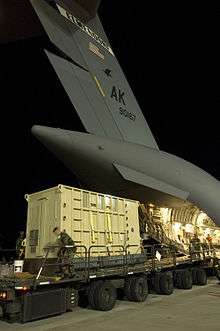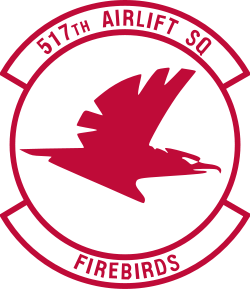517th Airlift Squadron
| 517th Airlift Squadron | |
|---|---|
|
517th Airlift Squadron Patch | |
| Active |
20 November 1940 - 31 July 1945 19 May 1947 - 10 September 1948 14 July 1952 - 21 July 1954 24 October 1960 - Present |
| Country | United States |
| Branch | United States Air Force |
| Type | Airlift |
| Part of |
Pacific Air Forces 11th Air Force 3d Wing 3d Operations Group |
| Garrison/HQ | Elmendorf Air Force Base |
| Nickname(s) | Firebirds |
| Engagements |
Operation Husky Operation Dragoon |
| Decorations |
Distinguished Unit Citation Air Force Outstanding Unit Award Republic of Vietnam Gallantry Cross with Palm |

The 517th Airlift Squadron (517 AS) is part of the 3d Wing at Joint Base Elmendorf-Richardson, Alaska. It operates C-12 Huron and C-17 Globemaster III aircraft providing airlfit in the Pacific theater.
Mission
The 517th Airlift Squadron provides tactical airlift operating C-17 and C-12F aircraft. Supporting worldwide airlift, airdrop, airland requirements while providing airlift for theater deployed forces and resupply of remote Alaskan long-range radar sites in support of PACOM, NORAD, and TRANSCOM. Provides aircrew qualification training for the U.S. Air Force.
History
Activated in December 1940 flying converted Douglas DC-2 transport aircraft as a GHQ Air Force transport squadron. Converted to C-47 Skytrains in early 1942, trained under I Troop Carrier Command for combat operations. Assigned to VIII Air Support Command, Eighth Air Force and deployed to England in August 1942, providing transport to the newly established American Air Force.
Was transferred to Algiers, Algeria in November 1942, and attached, being later assigned to Twelfth Air Force as part of the North African Campaign. The squadron's aircraft flew supplies to front-line units in Algeria and Tunisia as soon as suitable landing strips were available and evacuated casualties back to rear area field hospitals. A flight of the squadron deployed to Tenth Air Force in India during the fall of 1942, to assist in the re-supply of Brigadier General Merrill and his men, affectionately known as "Merrill's Marauders". It was during this Ceylon, Burma, India campaign that the squadron received its first Distinguished Unit Citation, returning to Tunisia by the end of the year.
The squadron moved to Sicily, dropping airborne forces onto the island during Operation Husky, then moved to forward airfields in Italy during 1943 as part of the Italian Campaign. Just prior to "D" Day, part of the 16th left India for Italy to tow gliders into France on "D" Day. In July 1944, the detached unit was joined by the remainder of the 16th TCS at Ciampino, Italy and as the European Theater closed in on Germany, part of the 16th again went on detached service to Rosignano, Italy, operating re-supply missions to Greek Partisans during September to October 1944.
In the fall of 1944, moved to France in support of Operation Anvil, the Allied invasion of Southern France, and supported ground forces moving north through the Rhone Valley to link up with Allied forces moving east from Normandy. Returned to Northern Italy in early 1945, supporting the drive into the Po River Valley and the end of combat in Italy during May 1945. The squadron also hauled food, clothing, medicine, gasoline, ordnance equipment, and other supplies to the front lines and evacuated patients to rear zone hospitals.
In late May 1945, after V-E Day, the squadron was moved to Waller Field, Trinidad and attached to Air Transport Command. From Trinidad, the squadron ferried returning military personnel to Morrison Field, Florida, where they were sent on to other bases or prepared for separation after the war. Inactivated at the end of July 1945.
It was activated but unmanned from 1947-1948. When reactivated again in the 1960 it resupplied Distant Early Warning (DEW) line sites in Northern Canada and radar sites in Greenland. Parts of the squadron deployed to South Vietnam from 1967-1968 to provide tactical airlift. It provided intratheater airlift within Alaska including support to forward operating bases, airland/airdrop of troops, equipment and supplies, and search and rescue as required. It provided C-130 crews for Pacific airlift to Southwest Asia, August–November 1990. Since 1992 the 517th provided worldwide combat airdrop, tactical air/land, operational support airlift, airlift for theater deployed forces and resupply of remote Alaskan long-range radar sites in support of PACAF. It has provided continuous rotational airlift and airdrop support in Afghanistan and Iraq since 2004. The 517th, flying C-130H1s, was among first United States units to participate in relief efforts following the Asian tsunami that occurred on 26 December 2004.
Operations and Decorations
- Combat Operations. World War II: Airborne assaults on Sicily and Southern France; support for partisans in Northern Italy, Jan-May 1945; aerial transportation in MTO, and briefly in CBI. Airlift of Army assault troops in training exercises, 1951-1954. Aircrew training, 1969–1993; flew humanitarian and resupply missions worldwide, including to Bosnia and Southwest Asia, 1993-2000. During WW II, members of a C-47 crew of the 17th Troop Carrier Squadron were credited with downing an enemy plane after they were attacked by Japanese fighter planes while on a mission near the Indo-Burmese border. See http://www.firebirds.org/menu1/thezero.htm [1]
- Campaigns. World War II: Algeria-French Morocco; Tunisia; Sicily; Naples-Foggia; Rome-Arno; Southern France; North Apennines; Po Valley, India-Burma. Vietnam: Vietnam Air Offensive; Vietnam Air Offensive, Phase II. Operation Desert Shield; Operation Enduring Freedom; Operation Iraqi Freedom
- Decorations. Distinguished Unit Citation: CBI Theater, 7 Apr-15 June 1944. Air Force Outstanding Unit Award with Combat "V" Device: 2 May 1967 – 1 January 1968. Air Force Outstanding Unit Awards: 1 July 1962 – 15 June 1964; 16 June 1964 – 31 May 1966; 8 July 1966 – 1 May 1967; 2 Jan-31 December 1968; 1 Jan-31 December 1969; 1 Jan-31 December 1970; 1 Jan-31 December 1971; 1 Jan-31 December 1972; 1 Jan-31 December 1974; 1 Jan-30 March 1975; 1 Jan-31 December 1979; 1 June 1986 – 31 May 1987; 1 June 1987 – 31 May 1989; 1 January 1994 – 31 December 1995; 1 January 1996 – 30 September 1998; 1 January 2000 – 31 December 2001; 1 January 2002 – 30 September 2003; 1 October 2003 – 30 September 2005. Republic of Vietnam Gallantry Cross with Palm: 1 September 1966 – 1 January 1968.
Lineage
- Constituted 17th Transport Squadron on 20 November 1940
- Activated on 11 December 1940
- Re-designated 17th Troop Carrier Squadron on 4 July 1942
- Inactivated on 31 July 1945
- Activated on 19 May 1947
- Inactivated on 10 September 1948
- Re-designated 17th Troop Carrier Squadron, Medium, on 3 July 1952
- Activated on 14 July 1952
- Inactivated on 21 July 1954
- Activated on 24 October 1960
- Organized on 8 February 1961
- Re-designated: 17th Troop Carrier Squadron on 8 December 1965
- Re-designated: 17th Tactical Airlift Squadron on 1 September 1967
- Re-designated: 517th Airlift Squadron on 1 April 1992.
Assignments
- 64th Transport (later, 64th Troop Carrier) Group, 11 December 1940 – 31 July 1945
- 64th Troop Carrier Group, 19 May 1947 – 10 September 1948; 14 July 1952 – 21 July 1954
- Tactical Air Command, 24 October 1960
- 64th Troop Carrier Wing, 8 February 1961
- 516th Troop Carrier Wing, 1 January 1963
- 5040th Air Base Wing, 15 June 1964
- 21st Composite Wing, 8 July 1966
- Twenty-Second Air Force, 31 March 1975
- 616th Military Airlift Group, 1 November 1975
- 3d Operations Group, 1 April 1992 – Present
Stations
|
|
Aircraft
|
|
References
![]() This article incorporates public domain material from the Air Force Historical Research Agency website http://www.afhra.af.mil/.
This article incorporates public domain material from the Air Force Historical Research Agency website http://www.afhra.af.mil/.
- Maurer, Maurer, ed. (1982) [1969]. Combat Squadrons of the Air Force, World War II (PDF) (reprint ed.). Washington, DC: Office of Air Force History. ISBN 0-405-12194-6. LCCN 70605402. OCLC 72556.
- ↑ 17th TCS Crew Downs Zero in WW II
External links
- "C-130 Dyess timeline". Abeline Reporter News. April 23, 2011. Retrieved January 29, 2014.


